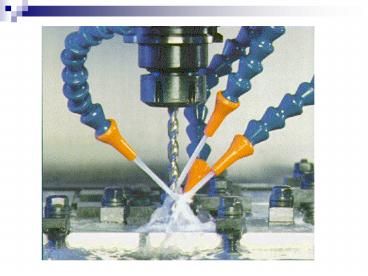Cutting Fluids - PowerPoint PPT Presentation
1 / 18
Title: Cutting Fluids
1
(No Transcript)
2
Cutting Fluids
3
Questions
- What are the functions of a cutting fluid
? - Name the 4 kinds of cutting fluid and
state how they differ. - What are the problems associated with
using cutting fluids ? - How should the fluid be applied to the
work area ? - Explain how the fluid circulation system
works.
4
The primary functions of cutting fluids in
machining are
- Lubricating the cutting process
- Cooling the workpiece
- and flushing away chips from the cutting zone.
5
Secondary functions include
- Corrosion protection of the machined surface
- enabling part handling by cooling the hot surface
6
Process effects
- improving tool life,
- reducing workpiece thermal deformation,
- improving surface finish
- Ease of Chip and Swarf handling
7
4 categories
- 1. Straight oils
- 2. Soluble oils
- 3. Semi-synthetic fluids
- 4. Synthetic fluids
8
Straight oils
- are the oldest class of engineered metal removal
fluids - used in machining operations in an undiluted
form. - They are composed of a base mineral or petroleum
oil and often contains polar lubricants such as
fats, - vegetable oils and esters as well as extreme
pressure additives such as Chlorine, Sulphur and
Phosphorus. - Straight oils provide the best lubrication and
the poorest cooling characteristics among cutting
fluids.
9
Soluble Oil
- form an emulsion when mixed with water.
- The concentrate consists of a base mineral oil
and emulsifiers to help produce a stable
emulsion. - They are used in a diluted form (usual
concentration 3 to 10) - provide good lubrication and heat transfer
performance. - They are widely used in industry and are the
least expensive among all cutting fluids.
10
Semi-synthetic fluids
- are essentially combination of synthetic and
soluble oil fluids - and have characteristics common to both types.
- The cost and heat transfer performance of
semi-synthetic fluids lie between those of
synthetic and soluble oil fluids.
11
Synthetic Fluids
- contain no petroleum or mineral oil base
- are formulated from alkaline inorganic and
organic compounds along with additives for
corrosion inhibition. - They are generally used in a diluted form (usual
concentration 3 to 10). - Synthetic fluids often provide the best cooling
performance among all cutting fluids.
12
Cutting Fluid Application
- The principal methods of cutting fluid
application include
13
Flood Application of Fluid
- a flood of cutting fluid is applied on the
workpiece
14
Jet Application of Fluid
- a jet of cutting fluid is applied on the
workpiece
15
Mist Application of Fluid
- cutting fluid is atomised by a jet of air
16
CUTTING FLUID HEALTH HAZARDS
- Workers are exposed to metal cutting fluids via
three routes - Skin exposure
- Aerial exposure
- Ingestion
17
- Skin exposure is the main problem 80
- Main cause of occupational contact dermatitis
- Solution ????
- Avoid prolonged contact
- e.g. Splash guards
18
Rancidity
- Rancidity caused by bacteria and other
microscopic organisms, growing and eventually
causing bad odors to form - Solution???
- Keep fluid clean and at proper strength































